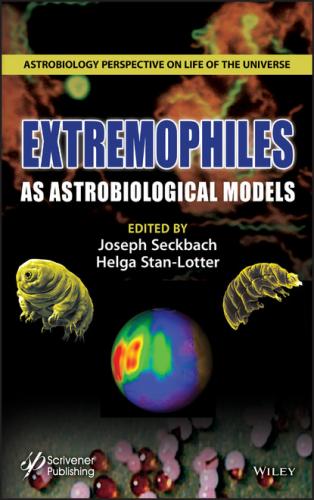Table of Contents
1 Cover
4 Preface
5
Part I: Extremophiles in Environments on Earth with Similarity to Space Conditions
1 Volcanic Steam Vents: Life at Low pH and High Temperature
1.1 Introduction
1.2 Steam Cave and Vent Sites
1.3 Steam Cave and Vent Sample Collection
1.4 Culture Isolation
1.5 Cell Structure of Isolates
1.6 Environmental Models
1.7 Conclusions
Acknowledgments
References
2 Rio Tinto: An Extreme Acidic Environmental Model of Astrobiological Interest
2.1 Introduction
2.2 Acidic Chemolithotrophy
2.3 Rio Tinto Basin
2.4 Biodiversity in the Tinto Basin
2.5 Tinto Basin Sedimentary Geomicrobiology
2.6 The Iberian Pyrite Belt Dark Biosphere
2.7 Methanogenesis in Non-Methanogenic Conditions
2.8 Rio Tinto: A Geochemical and Mineralogical Terrestrial Analog of Mars
2.9 Conclusions
References
3 Blossoms of Rot: Microbial Life in Saline Organic-Rich Sediments
3.1 Introduction
3.2 Overview of Saline Aquatic Systems
3.3 Prerequisites of Organic Carbon-Rich Sediment Genesis in Saline Lakes
3.4 Chemistry of Recent Organic Carbon-Rich Sediments in Saline Water Bodies
3.5 Microbial Life in Saline Sapropels
3.6 Relevance of Saline Sapropels
3.7 Concluding Remarks
Acknowledgments
References
4 The Haloarchaea of Great Salt Lake as Models for Potential Extant Life on Mars
4.1 The Great Salt Lake System in the Bonneville Basin
4.2 The Transformation of an Ancient Wet Mars to a Modern Hostile Environment
4.3 Life in Evaporitic Minerals on Earth
4.6 Extant or Extinct Haloarchaea on Mars?
4.7 Conclusions and Insights
Acknowledgments
References
5 Arsenic-and Light Hydrocarbon-Rich Hypersaline Soda Lakes and Their Resident Microbes as Possible Models for Extraterrestrial Biomes
5.1 Introduction
5.2 Mars
5.3 Enceladus
5.4 Titan
References
6 Antarctic Bacteria as Astrobiological Models
Abbreviations
6.1 Introduction
6.2 Antarctica as an Analogous Environment for Astrobiology
6.3 Astrobiological Environments of Interest
6.4 Bacterial Adaptations to Extreme Environments as Analogues for Astrobiology
6.5 Antarctic Bacteria as Analogues for Astrobiology
6.6 Endemic Antarctic Bacteria used in Astrobiology
6.7 Cosmopolitan Bacteria Found in Antarctica and used in Astrobiology
6.8 Conclusion
References
7 Extremophilic Life in Our Oceans as Models for Astrobiology
7.1 Introduction
7.2 Southern Ocean Ecosystem: West Antarctic Peninsula Region
7.3 Sea Ice Decline in WAP and Ice Shelf Collapse in Amundsen Sea
7.4 Deoxygenation Leading toward Hypoxic Zone in Amundsen Sea
7.5 Microbial Extremophiles in Southern Ocean
7.6 Chemosynthetic Abyssal Ecosystems
7.7 Hydrothermal Activity in Hrad Vallis on Mars
7.8 Why
